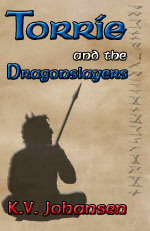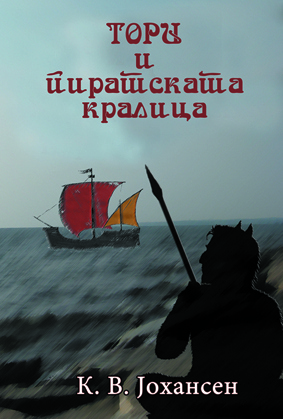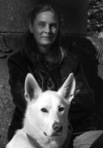K.V. Johansen's Blog, page 7
May 8, 2013
Skopje: The Old City, Сули ан and Чифте-амам
Even though my originally-planned booklaunch on the Friday of my trip had to be cancelled, Marija from my Macedonian publisher, Vermilion, had already set up a second reading for Saturday with a Roma organization, the NGO Sumnal. The visit with the children at Sumnal thus became the official launch of Тори и пиратската кралица. That was a really enjoyable morning, which I wrote about in my previous post. I’m really glad I had a chance to meet and talk with these kids,. After my visit to Sumnal, I joined David Chariandy and the others for an Albanian-language event introducing the Albanian translation of his book Soucouyant at the bookstore/coffeehouse Libraria e çarshisë in the Old Bazaar. After a long Macedonian outdoor lunch — more about food another time — Dejan, Nikola of Ikona, David and I met up with several others, including Dr. Elizabeta Seleva and Dr. Aleksandar Prokopiev, to see the Old City. Aleksandar, by the way, is a great champion of the Torrie books in Macedonian and spoke about them very passionately at the reception I wasn’t able to attend. (Thanks, it can’t be said often enough, to Air Canada deciding for no unavoidable reason at all to delay the first of my chain of three connecting flights for hours, so that I only reached Toronto as my flight to Istanbul was leaving without me.)
The river Vardar cuts through Skopje; most of the modern city lies to the south, while to the north is the Old City, which still shows the influence of many centuries of Ottoman rule in its architecture. In the oldest part, you walk through a web of narrow, crooked streets; it’s very much an evolved rather than a planned layout. Some of the cobbled lanes go up and down flights of steps. Cafes and bars spill outdoors; in the fine weather, everyone gathers outside to eat, drink, and socialize. None of the shops, with flats over them, are very large, and some are lower than modern street level. 
A typical street in the Old City section of Skopje.
It’s very much how I imagine the neighbourhoods of Marakand, the city where the eastern and western caravan roads meet in Blackdog, give or take the motorcycles. Like Marakand, Skopje has a history of earthquakes as well. The most recent bad one was in 1963, which destroyed much of the city and resulted in a lot of Eastern Bloc concrete going up in the modern sections. Many historic buildings were badly damaged then and have since been restored as well. However, you don’t get the feeling that the Old City is a fossil, a carefully-preserved display for tourists, the way some old places (downtown St. Andrew’s-By-the-Sea, for instance — very pretty, but the locals all shop in the neighbouring town of St. Stephen) can become; it’s still very much a living neighbourhood, concerned with its own affairs.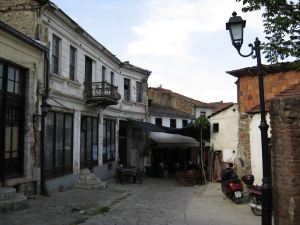
A street in the Old City, unusually empty of people, showing an old iron balcony.
The danger in that, of course, is that as the republic becomes more prosperous, there will be a rush to modernize and many of the oldest everyday buildings, some of which are now in very poor repair or abandoned, will be torn down rather than restored and kept in use.
An unusual view of a minaret.
Dejan and Nikola were taking us to the Čifte Amam National Art Gallery, Чифте-амам, located in a hammam or Turkish bathhouse. 
Some of our party heading into Čifte Amam.
My Bradt guidebook says it is early sixteenth century, commissioned by Isa Bey, but Wikipedia and other online sources date it to the mid fifteenth century. The mid fifteenth-century date makes more sense, since Isa Bey is İshakoğlu İsa Bey or Isa-Beg Isaković, who governed the Sanjak of Üsküb/Skopje from 1454-1463, right after the fall of Constantinople in 1453.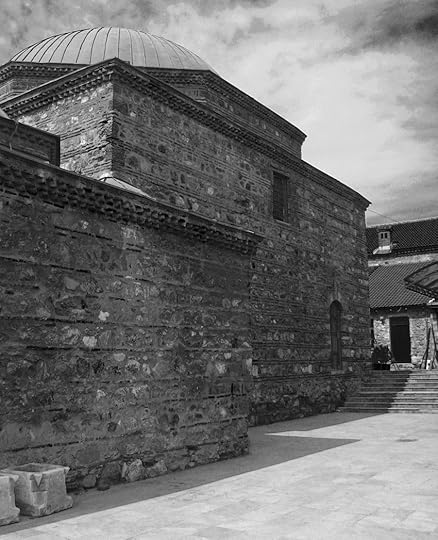
Čifte Amam
This is one of two hammams in the Old City that are now art galleries. Before we went in, though, Aleksandar beckoned me aside and we went off for a private excursion. He wanted me to see the Suli An.When I was in Skopje in 2010, I visited the City Museum in the old train station, with its Roman sarcophagi outside and its clock stopped at the moment of the 1963 earthquake, and the National Museum with its fascinating overview of the history of the area from the Neolithic onwards. I also saw the Ottoman fortress, built on a site, the strategic location of which has been utilized since at least the 2nd century B.C. and probably before. (Unfortunately, the site of Kale is now (2013) caught up in an ethnic/religious dispute and is closed to visitors.) On that trip, I also visited the Kuršumli An, a sixteenth-century Ottoman trading inn — a caravanserai — which is part of the National Museum. At that time, I was just about to submit Blackdog to Pyr; it was on my list of “things to do when I get home”, in fact. (Good thing I did stick to my list. Blackdog, with its caravanserais, its gods, goddessess, devils, and demons, was published by Pyr in 2011.) 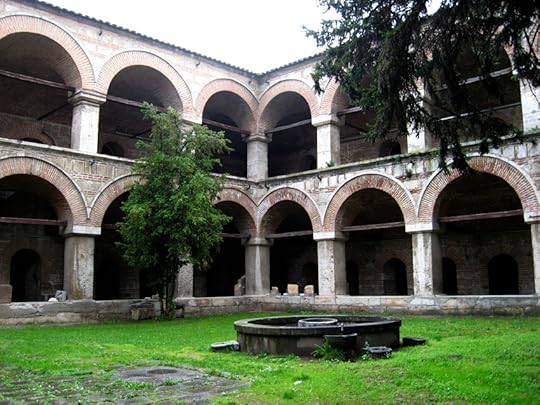
Kuršumli An when I visited it in 2010.
Seeing the reality of something I had only researched was a thrill; it confirmed some details I had made up because they seemed logical. I had written about it on my website at the time and now Aleksandar wanted to make sure I had a chance to see another of Skopje’s caravanserais.The Suli An, Сули ан, (“an” is the Turkish “han”, an inn), which like the nearby hammam was also built on the orders of Isa Bey, houses part of a university’s fine arts space and a museum about the bazaar, but the gatehouse and courtyard still preserve the look of the original architecture, though it was severely damaged in the 1963 earthquake and restored thereafter. (Just ignore the big glassed-in windows in the archways.) 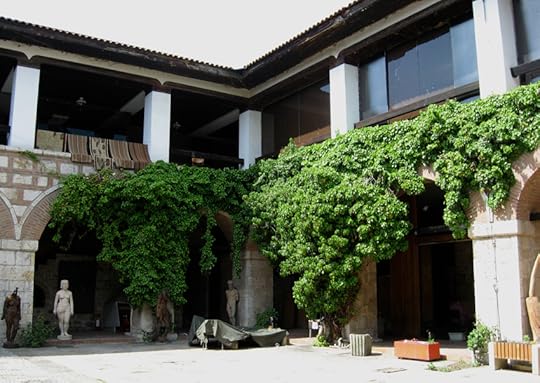
The Suli An in 2013.
After that, he took me to an antique shop in the Old Bazaar, full of all sorts of interesting oddments. Later, on a second visit, I would buy an old brass coffee mill there, which we find grinds much more nicely than our electric one.Back at the hammam, we rejoined the others. 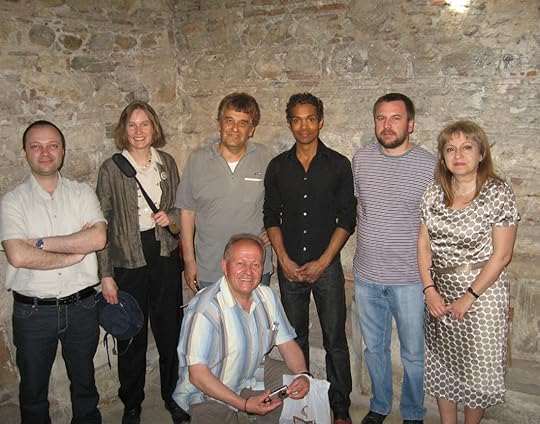
A roving gang of publishers, writers, and academics hanging out in the Čifte Amam.
There were a couple of interesting exhibitions in the galleries, but what interested me most was when Aleksandar showed me into a room that had been restored more to what it would have been, with some original artefacts, the fountains that were along the walls, sections of clay water-pipe and the like, rather than turned into gallery space.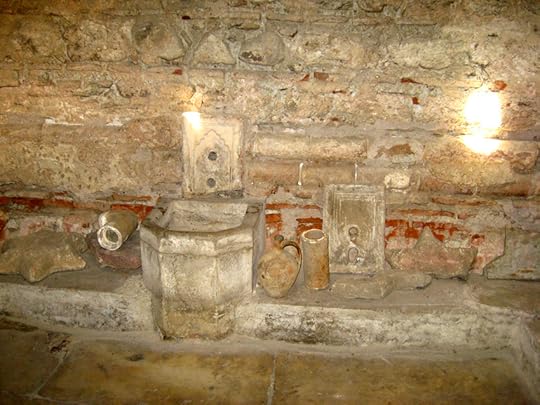
One of the fountains in the Čifte Amam.
One thing that struck me (luckily not literally, though it’s a hazard for us tall people), is how very low and narrow many of the original doorways are.
A doorway between rooms in the Čifte Amam National Art Gallery. Note the art!
The quality of the sound under the large domes changes quite dramatically depending on your position. It’s details like that that you don’t pick up from reading.
The truants, Dr. Aleksandar Prokopiev and I, reach the bathhouse at last.
Our next visit was to the nearby Monastery of Sveti Spas. The site has had a monastery on it since before the Ottoman conquest, but the church within the courtyard is built partially underground, like a Grubenhaus, because during the Ottoman era a Christian church was not allowed to be higher than a mosque; they excavated and built down, to allow for the height of a bell-tower. The current church is said to date from the 16th century, although it was apparently renovated extensively during the 19th and 20th centuries. There’s a very beautiful carved wooden iconostasis (which separates the nave from the sanctuary) made in the early nineteenth century. No photography is allowed in churches, so you’ll just have to imagine what it’s like, in the low light: an entire wall of small, densely-packed figures in high relief, worked in some polished dark wood (walnut, maybe?), depicting scenes from the Bible and from eastern hagiography, with coiling vines, flowers, and trees binding it all together.
Further posts are to come, talking about Macedonian food and Matka!


April 28, 2013
Macedonia at last
Well, here I am, starting my second (and last) day in Macedonia. I calculate that by the time I return I will have spent more time standing in queues in aiports than on foreign soil (if one disregards the fact that some of these queues have been on foreign soil), but no matter, I am here. 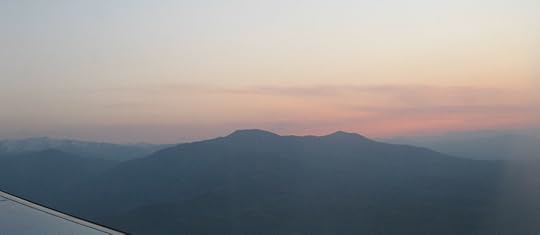
Sunset over Macedonia
It’s been an extremely busy trip so far. I arrived in the evening and went out for supper with Dejan Trajkoski, the event organizer, fellow Canadian author David Chariandy, Nikola Madeshovski from Ikona, and Dr. Elizabeta Sheleva. 
David Chariandy and myself, in Macedonia at last.
They had had a busy first day, with the reception with the Canadian Ambassador to Serbia and the introduction of the books being promoted, the Albanian-language translation of David’s Soucouyant and the Macedonian-language translation of my Torrie and the Pirate-Queen. Rumour has it (well, David told me), that Dr. Alexander Prokopiev spoke about Torrie with great enthusiasm, so I was well-represented and championed even in my absence.Unfortunately, due to the much-delayed flight (and it turns out it wasn’t fog but merely organizational problems that the airline knew about in advance and I think therefore should have informed me of and changed my flight to an earlier one, since my connection was on record — they have no excuse), the planned reading and book launch with schoolchildren from Skopje on Friday had to be cancelled. However, on Saturday morning I visited the NGO Sumnal, a charity which works with Roma children, and so the official introduction of the Macedonian Torrie and the Pirate-Queen took place there instead. 
The Roma flag: a cartwheel against grass and sky.
The kids were a great audience and my young translator did an excellent job. Although they were very shy, the children did ask a lot of questions and I think we all enjoyed ourselves immensely.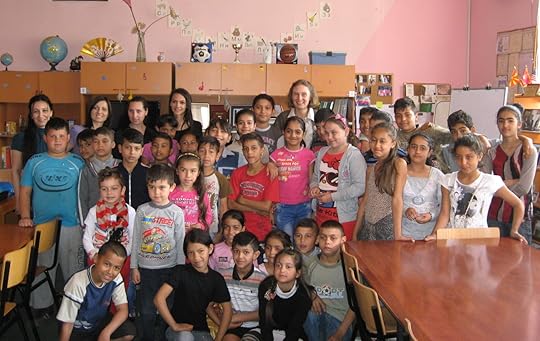 They wanted to know if I had tried Macedonian food; I was able to tell them that yes, the organizers had been taking me to restaurants for lot of traditional Macedonian foods and that I even made tavche gravche (a baked-bean type dish with paprika rather than molasses and mustard) at home. They laughed a lot at this; turns out that their thank-you gift to me was a little earthenware dish traditionally used for tavche gravche.
They wanted to know if I had tried Macedonian food; I was able to tell them that yes, the organizers had been taking me to restaurants for lot of traditional Macedonian foods and that I even made tavche gravche (a baked-bean type dish with paprika rather than molasses and mustard) at home. They laughed a lot at this; turns out that their thank-you gift to me was a little earthenware dish traditionally used for tavche gravche. After that, I rejoined Dejan, Nikola, and David at an Albanian-language bookstore/cafe in the Old Bazaar, where we were presented at an Albanian-language event focussed on the translation of David’s book. We spent a lot of time touring the Old City with Dejan, Nikola, Elizabeta Sheleva, and Alexander Prokopiev. 
A typical view in the Old City.
I think I’ll write up that as a separate post later, with lots of photos. A caravanserai, a bathhouse, a medieval church … it needs its own space. A
An Ottoman bath-house, now an art gallery. More photos of the Old City to come in a separate post!
fter a book-signing at an Ikona store went out for another traditional Macedonian meal at the “Old City House” restaurant.Here is some Macedonian coverage of the first day of the event. (The day I missed thanks to Air Canada.)
> From the news site Vecher
> From another news site
> And from an arts and culture website.


April 25, 2013
Going nowhere, slowly
Well, the Macedonian expedition is not off to a very good start. My flight from Moncton was delayed by a couple of hours; I still don’t know why. Fog? But it got in just when the flight to Istanbul was leaving. I could hear myself being paged. I told the Air Canada flunky at the gate I was here, asked where to go. She told me. I went. It was a flight to Halifax that had already gone. I went back. She gave me new directions. I ran. I ran for I don’t know how long; long enough to trigger off the asthsma that’s been in abeyance for years and end up wheezing and faint at the gate. Security of some sort had opened a door and waved me through. The Turkish ticket people had seen me coming, taken my boarding pass, told me to breathe (having a few problems with that at the time), and told me my baggage would not arrive with me. Then they were told tough luck, she’s not gettng on. About five minutes later, four other people showed up, from two other late Air Canada connecting flights.
And thus our epic journey began, not not to Istanbul, but in quest of someone, anyone, who could actually do something useful. Air Canada said “Oh well,” and gave everyone a hotel chit and a gosh, ten dollar meal chit, telling us the meal places were probably closed. They could not rebook our flights. No, we had to do that by going to a bank of white phones. Did I mention that we were sent to several different Air Canada desks before that bit of information was conveyed to us?
We were also supposed to go and get our baggage off the domesitc carosel. Tickets first, we all thought. It took several hours on the phone. I don’t think I’m exaggerating, because of the hour at which we finally reached the hotel. Something must have happened in that time. Many things, in fact, happened. The desks shut down. The cleaners began to throw chemicals on the floor, wearing breathing masks and whirling away with giant chemical-whirlers, occasionally coming over to tell us to all go away. This we politely refused to do, as some of us were getting through.
One lady had no common language with any of the rest of us, except that she understood a very little French. I discovered I could, in a pinch, speak a very little that did not have too much German mixed in, and that was what we got by on, until one of the others helped her reach a Russian speaking AC phone flunkie. After a couple of hours, and various calls on the gentlemen’s cell phones to the relatives of the lady we couldn’t really say anything complex too, we were all assured our tickets were fixed up for flights the next day.
(This means I am missing the launch of the Macedonian translation of Torrie and the Pirate-Queen with the schoolchildren of Skopje, as well as the reception with the Canadian Ambassador to Serbia and some philology professors.)
We then attempted to retrieve our luggage. Although a baggage chap did his best, we were kindly assured that the Air Canada person didn’t know what she was talking about and our baggage was not about to show up because everyone had gone home to bed, come back in the morning. Oh, and they couldn’t find the baggage of the lady who didn’t speak English or French, though the rest of us were assured our baggage existed, somewhere else.
So, we found the hotel shuttle. This was getting on for two a.m. local time. The hotel had no rooms. They found rooms, after a fashion. I had a suite with gold-plated (well, it was trying to look that way) taps, but no hot water except in the sink. The couple ended up letting themselves into a room that was already occupied. Another gentleman had a room that was out of service due to decaying food in the fridge, apparently, but it was that or the couch in the lobby. But at least we weren’t camped in Pearson. Plus, they gave me toothpaste. I can forgive a lot for that. It was hardly their fault Air Canada didn’t check on whether any rooms actually existed.
Come morning, all bags but one appeared. We decended in force upon the baggage people and after some phoning, our party of waifs’ last bag appeared. We descended upon Air Canada to claim our promised tickets. The couple got through no problem, but the other three of us all had difficulties, apparently engendered by the call centre people. The last two of us stuck with the lady who didn’t speak English and eventually an Air Canada person who was doing his honest best found someone on the phone who could explain the details of his efforts to her. Some of us had to go away and wait and come back later when other airlines people would be answering their phones. In my case, the problem was that the call centre person appeared to have cancelled the Skopje to Istanbul leg of my return flight. Since I can’t teleport and am not about to hike across the Balkans, whatever Patrick Leigh Fermor may once have done in differently interesting times, I felt this perhaps ought to be resolved.
Meanwhile, we last two got our non-Canadian friend’s ticket problems sorted, thanks to the one helpful Air Canada chap who worked into his lunch hour to do it and found us in yet another lineup to give it to her. We saw her to get her boarding pass and to security. I hope the rest of her trip is uneventful. Next time, I expect her family will be instructed to come visit her, none of this sending tickets!
And much after that, I persuaded someone at Air Canada that perhaps I needed to be able to fly out of Skopje and that as they had cancelled it, they could darn well uncancel it. They allege they have done so. The proof, unfortunately, awaits the transformation of a Lufthansa lineup into a Turkish lineup, which hasn’t happened yet. Two more hours to go before I can join yet another queue and find out if, just maybe, I will be flying to Istanbul tonight and on to Skopje.
And back. Let’s not forget back.
What none of the five castaways understand is that we all had connecting flights; we were all on their computers; they are all allied airlines. They knew were were en route. They knew our planes were arriving just at the departure time. Waiting ten for fifteen minutes for us to run the length or breadth or round and round or wahtever it was of Pearson would not have delayed that flight significantly at all. The planes were all several hours late; they had ample warning of the situation. We could have informed at our plane-exiting of where to go (correctly, mind you. In my case, the misdirection probably made that one minute’s difference). None of this was necessary at all. It has caused entirely undue stress to a lady alone in a foreign land, caused lots of problems for others, ruined plans for the most important parts of a literary festival that many people have been working very hard at, and investing much time and money in, since last June.
At least we all made some new friends. I hope I, or anyone else lost and alone in a foriegn land without any common tongue to get by on, can find such a gang to stand by them in our turn.
With luck, I will be off for two days in Macedonia in another few hours. I’m afraid my efforts to learn Macedonian are not going to do me much good. I’m exhausted and have been trying to think intermittantly in French for the past many hours, to the point that when I accidentally ran a trolley into the luggage of a man speaking Chinese, I apologized in French. I guess it’s temporarily been elevated to default foreign language, though I notied in the last hour or so that German is being to reassert itself.
Anyway, that’s my update for now. We still have a reading at a Roma children’s charitable group scheduled, so I will get to meet some children and introduce them to Torrie. I will have spent more time travelling than being there, though.
Pearson International, in my opinion, is one of the lower circles of hell.


April 22, 2013
Blackdog ebooks
A couple of people have pointed out to me that the Blackdog ebooks disappeared outside of the US for a while. I checked with Pyr and that problem has been fixed. 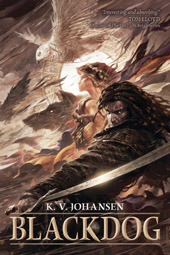 Here are the new, updated links for the ebook editions.
Here are the new, updated links for the ebook editions.
And Blackdog at Amazon US and Barnes and Noble, which are the same links as before.


April 20, 2013
Torrie and the Dragonslayers ebook
It’s been a very good week for Torrie. First the Macedonian translation of Torrie and the Pirate-Queen, Тори и пиратската кралица, came out, and now the ebook edition of Torrie and the Dragonslayers is available through Kobo (and probably a few other places as well).
Dragonslayers (2009) is the completely new retelling of my very first book, Torrie and the Dragon, from long, long ago. (Well, 1997 seems like long, long ago.) As I say in the introduction, it’s not merely revised, but retold, as though you’re listening to a different night of storytelling in the Wild Forest and Torrie is putting in all the things he left out the first time. The ebook edition contains a bonus short story as well, “How Torrie met Cossypha”.


April 17, 2013
Cover for Macedonian Torrie and the Pirate-Queen / Тори и пиратската кралица
Cover art for Macedonian translation of Torrie and the Pirate-Queen.
Here’s the cover for the new Macedonian translation of Torrie and the Pirate-Queen, translated by Marija Todorova and published by Vermilion. In a week, I’ll be in Skopje, the Republic of Macedonia, to promote it and take part in the “Days of Canadian Literature in Macedonia” event.


April 10, 2013
I’ve put it on the list, to be sure it won’t be missed …
Two weeks till Macedonia. The List is running something like this:
Book to read on the plane: re-reading Berg’s Restoration, check. I was going to take the chance to read the third volume of Roberson’s Tiger and Del omnibuses, because I actually missed books five and six back in the day, somehow, but it’s a whacking great trade paperback that probably weighs about a kilogram, so it will have to stay at home.
Nevertheless … another book for when the first one runs out: Lightweight travelling copy of LR, because it’s good to have an old friend along, check.
Torrie and the Pirate-Queen, for reading from at booklaunch. Check.
Notebook computer, because I find I feel twitchy at the thought of the Kobo ereader/tablet being my only interface with the world: check. Since Kobo books are resident on any device you have enabled for them, I can still finish reading McKillip’s Wonders of the Invisible World, too. (I always go on trips with far more books than I’ll ever have time to read, due to the childhood trauma of frequently running out of Things to Read while enduring long summers at my grandmother’s.)
Eastern European phrasebook: check. Ditto Bradt Guide to Macedonia. I have in fact been trying to learn Macedonian since sometime last summer, with limited success. Dick Hannay, I am not. I always seem to end up with a basic grasp of grammar and no vocabulary. Ah well, show me a verb and after a bit of thought I can maybe tell you what it’s doing. (Depending on degree of plane-induced exhaustion, of course.) Don’t ask me what it means, though. Possibly this stems from studying languages in a atmosphere where what was essential was being able to parse the paragraph; once you’ve done that, all you need is a dictionary. Problem is, I have no Macedonian dictionary. And none of this is useful for, “Hello, um, I’m the author — is this where I’m supposed to be?”
Ironing: done. Mostly. See? I have thought of some of the more normal, useful things, like clothes.
There. The list, proof that everything is under control. I have Organized the books necessary to the expedition, and that’s half the battle. I can relax now. Really.


April 7, 2013
Preparing for a adventure … Mrs Pollifax as travel guru
It’s funny, but when I think of travel abroad, the literary example which comes to mind as an archetypal traveller and figure to emulate is Dorothy Gilman’s Mrs Pollifax, that geranium-growing grandmother and part-time CIA agent who carried her gentle, 1960′s tolerance, enthusiasm, and curiosity about the world unchanged (and unaging!) through decades, from her first appearance in 1966 to the fourteenth volume in 2000. Buchan’s Dick Hannay gets in there, of course. I know that one shouldn’t set off without some chocolate and ginger biscuits and a toothbrush in one’s pocket, and that one must, of course, be able to speak the language like a native, whether it’s Afrikaans, German, or Scots. I know that one’s malaria should act up at a plot-convenient moment. (Fortunately malaria hasn’t been known in Macedonia since, well, Hannay’s time, actually, so I shan’t be acquiring that particular Hannay-like attribute. Wish I could pick up his or Sandy’s skill for acquiring languages, though.) However, it’s Mrs Pollifax I end up thinking of as I pack.
Why is that? I think it’s because Mrs Pollifax always embarks on her journeys with open-minded enthusiasm. She’s willing and eager to be fascinated and delighted, wherever it is she’s going. This strikes me as an appropriate and useful philosophy for travel, an attitude worthy of cultivation. Also, she makes lists. Lack of a flashlight, suitable shoes, or an appropriate hat will not keep her confined to her room, should conditions require such. The lesson I take from that is that bandages for blisters, an umbrella or rain-poncho — these can make all the difference between enjoying an outing and being uncomfortable and unhappy, whatever the weather. Mrs Pollifax reads (if she’s allowed time) guidebooks. This means that she usually sets off with a little background knowledge against which to pin what she encounters, and, of course, a map. Well, last time my guidebook was at least good for providing amusement to my Macedonian friends, but I’m someone who feels really lost without a map against which to track the physical reality of where I am. (Which reminds me, I have a map of Skopje somewhere, must find that. Put it on the list …) Furthermore, Mrs Pollifax heads, if she has time, to New York, to buy herself a new (and usually somewhat startling) wardrobe. I bought a nice linen jacket and a pair of lightweight boots suitable for both formal receptions and sidewalk hiking at the Salvation Army. To each their own budget.
So, with the voice of Mrs Pollifax in my ear, and some emergency chocolate and biscuits, à la Hannay, in my rucksack, I think I am nearly ready.
Seventeen days till Macedonia.


March 24, 2013
Days of Canadian Literature in Macedonia
Press Release
March 25, 2013
New Brunswick Author to be Guest at International Literary Festival
Launch of Second Macedonian Translation
K. V. Johansen, New Brunswick author of twenty books for children and adults, is to be one of two main participants at the “Days of Canadian Literature” Festival in Skopje, the Republic of Macedonia, April 26-28. There, she will attend the launch of the Macedonian edition of her children’s novel, Torrie and the Pirate-Queen, Тори и пиратската кралица, translated by Marija Todorova and published by Vermilion. This is the second of her Torrie series to be translated into Macedonian; in 2010 the translation of Torrie and the Snake-Prince, Тори и принцот-змија, received the first-ever “International Ana Frank Award for Children’s Literature”, Меѓународната Награда „Ана Франк“ за најдобра книга, for children’s literature in Macedonian. Johansen, a scholar who has written two books on the history of children’s fantasy literature, will also be taking part in a discussion of multicultural voices in Canadian literature.
Kale, Skopje, Republic of Macedonia
For more information on Johansen’s works, please visit her websites at: http://www.kvj.ca or http://www.pippin.ca
Johansen’s travel is supported by the Canada Council for the Arts.
Cette tournée est soutenue par le Conseil des Arts du Canada.
For author photos, cover images, or to arrange interviews, please contact via this form.


March 8, 2013
Max Ferguson
I was saddened to learn of the death yesterday of Max Ferguson, one of the great CBC personalities. Although I never met him face to face, we had corresponded a little when I compiled the appendix to a new edition of his Leacock Award winning memoir of his first twenty years in the CBC And Now … Here’s Max (still in print, see link below), and his was a familiar voice of my teen years. I’ve noticed that the obituaries are mentioning, of course, his satire, capable of stirring up Parliament — though the CBC one avoids mentioning how often he was in conflict with the Holy Mother Corp (the phrase is his colleague Allen McPhee’s, I think) and how often the CBC itself was his target. (It’s still possible to listen to clips of his shows; there are links to various items through his publisher’s website here.) I had come to know Max when I was quite young, through my father’s copy of And Now … Here’s Max, which I read and chortled over several times, but on air, it was through folk music that I discovered him as something other than a literary character. I haven’t seen anything mentioning that after he retired from being Canada’s gadfly, he still had a weekly show, still called “The Max Ferguson Show”, on which he played what is now called world music, though back in the eighties and nineties it was just folk music from around the world. For introducing me to The Corries, Maddy Prior and the Carnival Band, Loreena McKennitt, music from Scotland and Bulgaria, South Africa and Ireland, England, Canada, Finland, Russia and South American, I’d like to thank him once more. He greatly enriched my musical life.



